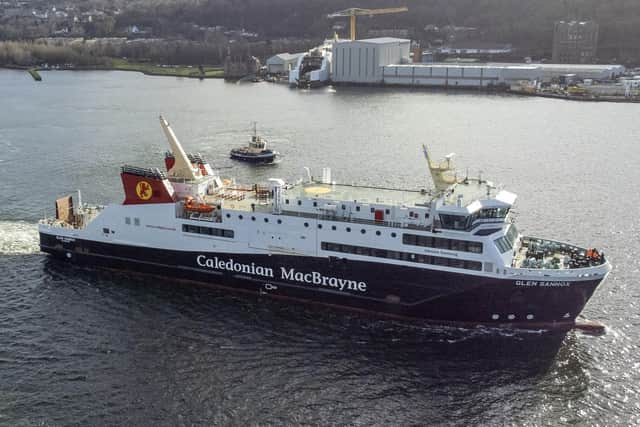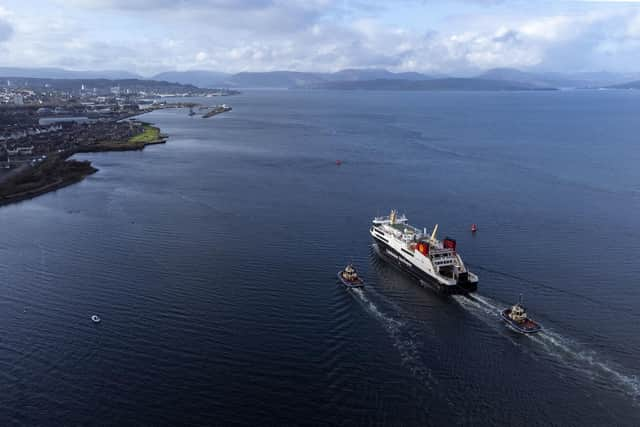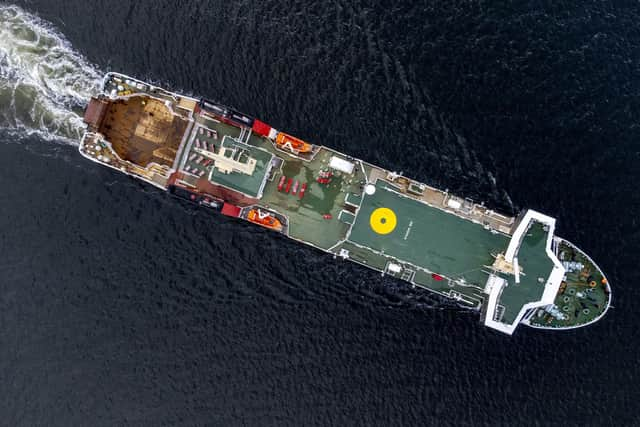‘Colossal scandal’ over Scottish Government’s handling of ferries as Scottish Conservatives uncover another £4m of unplanned CalMac maintenance
Nearly £4 million of unplanned maintenance on CalMac’s ageing fleet has been condemned as part of a “colossal scandal” as one of its massively-delayed new vessels finally moved under its own power at the start of sea trials.
The Ferguson Marine-built Glen Sannox sailed down the Clyde six years after it should have entered service on the main Arran route, which has left the west coast operator struggling to keep some of its vessels which are more than 30 years old working reliably.
Advertisement
Hide AdAdvertisement
Hide AdThe Scottish Conservatives published a freedom of information (FoI) request which found CalMac spent £3.85m on unscheduled work between April and November 2023 compared to £3.05m in the year to March 2023 and £3.3m in the previous year.
The £3.85m of unplanned work to last November – the most recent figures provided in the FoI response – compares to £17.68m of planned work over the same period.
CalMac ferry fares could rise up to 40 per cent for island visitors under Scottish Government review
CalMac said its total maintenance bill had doubled in six years, although the FoI response showed it had fallen from £28.4m in 2021-22 to £26.6m in 2022-23 .
Scottish Conservatives transport spokesperson Graham Simpson said: "This huge increase in unplanned maintenance costs is the inevitable consequence of the SNP Government's rampant neglect of islanders, and the lifeline ferries on which they rely.


"Much of CalMac's fleet is at or beyond the end of its natural life, and is therefore prone to break down.
"This unplanned maintenance is not only taking money away from CalMac's other priorities and imposing costs on the Scottish taxpayer, it means that islanders have to suffer unreliable and frequently disrupted services.
"The SNP-Green Government's mismanagement of ferries – in procurement, replacement, funding and maintenance – is a colossal scandal.
"It has cost hundreds of millions of pounds, inflicted huge damage on island economies, crippled tourism, and caused needless misery for some of our most vulnerable and neglected communities."


Advertisement
Hide AdAdvertisement
Hide AdCalMac chief executive Robbie Drummond said: "With one third of our 35 vessels operating beyond their life expectancy, we are investing heavily in both planned and unplanned maintenance as we work hard to provide the best possible service we can to the communities and customers we serve.
"This investment in maintenance grew to well over £43m in 2023, compared with just £20m in 2017.
"We are looking forward to welcoming a total of six major and ten small vessels into the fleet over the next five years. However, we face a difficult period as we wait in anticipation for them to be fully operational on the network.


"In the meantime, we will continue to work in partnership with local stakeholders and communities to ensure the best possible outcomes for all who rely on our services."
A spokesperson for the Scottish Government’s Transport Scotland agency said: “Maintenance spend is a requirement of all ferry fleets spend and CalMac is investing additional sums to improve fleet sustainability and to provide a more resilient service for customers and communities, ensuring all planned and unplanned maintenance can be met.
“Our Islands Connectivity Plan has been published for consultation, looking at a wide range of issues, from improving fleet reliability and monitoring performance, to reducing carbon emissions and making future contracts more flexible to respond to community needs.
“We recognise the impact that delays and disruption have regrettably had on our island communities and are committed to investing in our ferry services.
"Delivering six new major vessels to serve Scotland’s ferry network by 2026 is a priority for this Government.
Advertisement
Hide AdAdvertisement
Hide Ad"We have invested more than £2 billion in our ferry services since 2007 and we have outlined plans to invest around £700 million in a five year plan to improve ferry infrastructure.
“We share the desires of island communities for sustainable and effective ferry services and look forward to continuing our constructive engagement with them on future services and vessel replacements.”
Glen Sannox is due to replace 31-year-old Caledonian Isles on the Arran route to Brodick but is not expected to be completed by Ferguson Marine until at least late May and not be carrying passengers to late July or early August.
The ferry will be CalMac’s second largest, along with sister vessel Glen Rosa, with space for 852 passengers and 127 cars.
At the start of the sea trials, the ship was initially attached by a line to a tug for safety while accompanied by two others. However,it was later seen operating untethered and heading past Gourock – far further than had been expected on the first day of the three-day tests.
Ferguson Marine had said it was only due to travel as far as Greenock initially, and not go as far as Gourock or unattached to a tug until Wednesday.
The trials included a variety of manoeuvres using its propellers and bow thruster, and deploying its anchor, in what Ferguson Marne chief executive David Tydeman described on Tuesday as an “key milestone”.
He said: “Today, Glen Sannox confidently left the quayside under her own propulsion for the first time. She sounded her horn and began the first in a series of rigorous sea trials.
Advertisement
Hide AdAdvertisement
Hide Ad"We began with the anchor and moved onto propulsion and manoeuvring tests. This will continue for the rest of the week.
"I would like to thank my colleagues at the shipyard and the team at [Scottish Government ferry owning and ordering body] Caledonian Maritime Assets Limited for their hard work in achieving this key milestone.
"As the four-hour trials went so well, and the weather conditions were favourable, she was able to make a longer journey than was previously anticipated for day one.
"She sailed as far as Gourock under her own control and was untethered from her tug soon after leaving the shipyard quayside.
"Only using gentle speeds of 4-5 knots and gradually putting power loads on to the engines on her first day, she will start to stretch her legs more on Wednsday and Thursday.”
The 102m-long vessel, which is 8m longer than the Caledonian Isles which it is due to replace, is scheduled to move to dry dock for further work in March before further trials and completion in late May.
However Ferguson Marine, which was saved from collapse by being taken over by the Scottish Government in 2019, has still to announce the results of its latest review which could include a further delay and increase to its cost.
Glen Sannox and Glen Rosa are already more than three times over their original combined £97 million budget, which has been largely blamed, along with the colossal delays, on the shipyard’s private sector management which won the order in 2015.
Advertisement
Hide AdAdvertisement
Hide AdGlen Sannox is due to undergo two months of testing with CalMac before entering passenger service to Brodick in Arran, which is expected to be in late July or early August if delivery by the shipyard is not further postponed.
The ferry will operate from Troon rather than the route’s current mainland port of Ardrossan while it is upgraded to take the larger vessel.
However, there is increasing uncertainty over the work because it has yet to be agreed and ministers have failed to reaffirm their commitment to the North Ayrshire port as the long-term base for sailings.
Comments
Want to join the conversation? Please or to comment on this article.